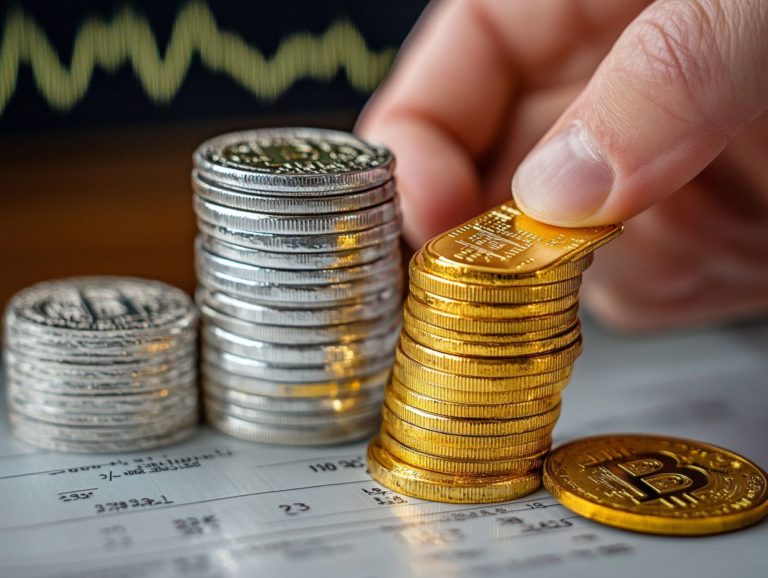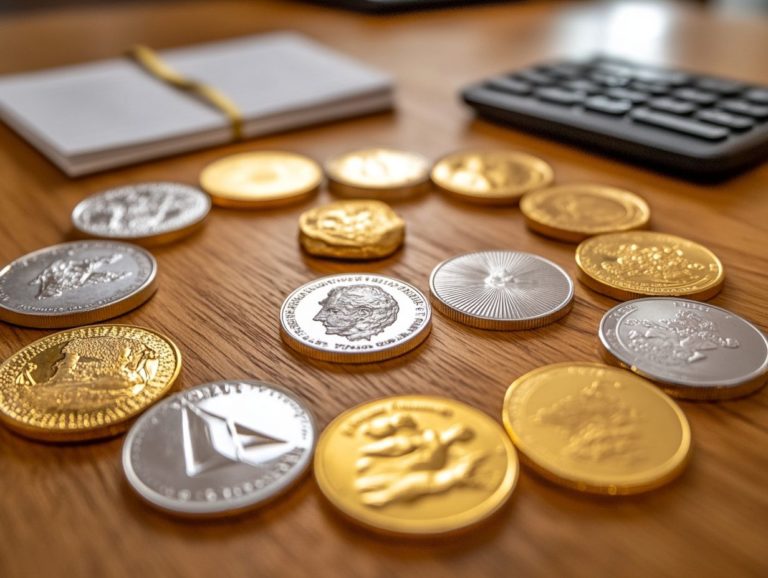How to Invest in Gold?
Investing in gold is a popular strategy for anyone looking to diversify their portfolio and protect against economic uncertainty.
With various options available from tangible gold to paper assets like exchange-traded funds (ETFs) and stocks understanding your choices is essential.
This guide reveals how you can dive right into gold investment! Uncover potential returns and learn how to reduce risks as you explore the compelling world of gold investment.
Contents
Key Takeaways:
- Diversify your portfolio by investing in gold, a stable and globally recognized asset.
- Consider your risk tolerance and investment goals before choosing between physical gold or paper gold through ETFs or stocks.
- To begin investing in gold, open a gold investment account and choose a reputable dealer who offers potential returns and risk reduction strategies.
Why Invest in Gold?
Investing in gold is a smart choice for protecting against inflation and economic downturns.
This valuable metal holds its worth and acts as a safe haven during times of financial uncertainty.
By diversifying your investment portfolio to include assets such as physical gold, gold ETFs, and gold coins, you can effectively reduce risks while positioning yourself for potentially substantial returns.
Partnering with reputable dealers and exploring strategies like gold IRAs can further elevate your opportunity to build wealth through this enduring asset class.
Ways to Invest in Gold
Investing in gold opens up a world of possibilities, with each method presenting its own set of advantages and risks.
You can opt for tangible assets like physical gold or gold bullion, which offer a certain tactile appeal, or explore financial instruments such as gold ETFs and mutual funds that provide ease and liquidity.
Explore gold mining stocks or engage in futures and options trading to enhance your portfolio’s growth potential and diversification.
These varied avenues cater to a spectrum of investment strategies and risk tolerances, allowing you to tailor your approach to fit your financial goals.
Physical Gold vs. Paper Gold
The debate surrounding physical gold versus paper gold, like gold ETFs, revolves around ownership and investment strategy, as each serves distinct purposes.
Physical gold, such as bullion and coins, offers tangible value and a sense of security, while paper gold provides liquidity and ease of trading in the financial markets.
It s crucial for you to understand the differences between both forms to make well-informed investment decisions.
When determining which form of gold aligns with your individual needs and goals, consider your priorities.
If you re looking for a long-term store of value and a hedge against inflation, you might lean towards investing in gold bullion or coins.
These tangible assets can provide you with peace of mind during economic uncertainty.
However, if you prefer quick transactions and the flexibility to rebalance your portfolio easily, gold ETFs may be the more appealing choice.
Each option offers unique merits, and weighing these benefits in context will lead you to more strategic investment allocations.
Gold ETFs vs. Gold Stocks
Gold ETFs and gold stocks offer distinct investment opportunities for you, each providing a unique way to engage with the gold market. While gold ETFs like SPDR Gold Shares ETF present a straightforward method for tapping into gold’s price movements, gold stocks such as Newmont Corp., Barrick Gold Corp., and Franco-Nevada Corp. can deliver dividends and growth potential tied to company performance. Grasping these differences is essential for effective portfolio diversification.
You might find that gold ETFs serve as an affordable option for gaining exposure to gold price fluctuations. This makes them ideal for those who appreciate simplicity and direct market correlation.
On the flip side, investing in gold stocks includes factors like how well a company runs its operations, management effectiveness, and global events that may affect gold, all of which can influence performance.
While gold stocks may offer substantial upside from rising gold prices along with the possibility of earning dividends, they also come with risks tied to mining operations and market volatility. Ultimately, your choice between these two avenues will hinge on your individual risk tolerance, investment objectives, and your appetite for diversification within your overall portfolio.
Factors to Consider Before Investing in Gold
Before you dive into gold investing, consider these crucial factors! It s essential to assess several key aspects that can significantly impact your success. Think about your risk tolerance, investment goals, and the current economic landscape.
By understanding how gold prices respond to inflation and market trends, you’ll be better equipped to make informed decisions that align with your financial objectives. This comprehensive evaluation will guide you in selecting the most suitable investment strategy, whether it’s physical gold, gold ETFs, or gold stocks.
Risk Tolerance and Investment Goals
Assessing your risk tolerance and defining your investment goals is crucial before diving into gold. This understanding shapes your strategy and influences the types of gold products you select.
With this foundational knowledge, you can tailor your approach, ensuring that your gold investments resonate with your financial aspirations and your comfort level with market fluctuations. If you lean towards a conservative strategy, you might consider a gold IRA, which offers tax advantages and stability through long-term holdings.
Conversely, if your appetite for risk is higher, you could explore physical gold like coins and bars or even gold mining stocks, positioning yourself to capitalize on the potential for greater returns. By recognizing your unique risk profile, you can adeptly navigate the gold market and implement effective diversification strategies that bolster the resilience of your overall portfolio.
Market Trends and Economic Factors
Analyzing market trends and economic factors is essential if you want to predict gold prices and make informed investment decisions. Recent fluctuations in currency values, particularly the U.S. dollar, can send shockwaves through the gold market, underscoring the importance of tracking these developments closely.
When interest rates rise, gold investments often take a backseat as other assets start to look more attractive. Therefore, grasping the interplay between these economic indicators is crucial for your strategy.
The ongoing global shift towards sustainable and alternative investments could significantly reshape demand for precious metals. By staying attuned to these trends, you can navigate the complexities of the market more effectively, ensuring that your decisions are timely and strategically aligned with your financial goals.
How to Start Investing in Gold
Investing in gold necessitates a strategic approach, beginning with the careful selection of a suitable gold investment account or gold IRA. It’s essential for you to identify reputable dealers when acquiring physical gold, whether that means coins or bullion.
Understanding the intricacies of the gold market will give you the power to navigate your investment journey successfully. By establishing a solid foundation, you can reap the benefits that gold brings to your portfolio.
Start your gold investment journey today and watch your portfolio shine!
Opening a Gold Investment Account
Opening a gold investment account, especially a gold IRA, is an important step toward securing your financial future with gold. This specialized account lets you hold physical gold and other precious metals in a way that can help you save on taxes.
To begin, gather essential paperwork like identification documents, proof of address, and tax information. As you explore gold investments, you’ll find options ranging from physical bullion to mining stocks. Each choice offers its own benefits and risks, so conduct thorough research on tax-free gold investments.
Selecting trustworthy dealers protects your assets and enhances your investment experience. They provide valuable guidance and help you stay compliant with IRS regulations. A well-structured gold investment account can be a strong foundation for your financial resilience.
Choosing a Reputable Dealer
Choosing a reputable dealer is essential when investing in physical gold, whether it s coins or bullion. This ensures the authenticity and value of your purchase.
Research dealers carefully. Read reviews and verify certifications to build trust and protect your investment. Let quality and transparency guide your decisions.
Evaluate not only their credentials but also their standing in the community. Customer reviews reveal previous buyers’ experiences, showing the dealer’s reliability and service quality.
Look for pricing transparency; a reputable dealer offers competitive rates without hidden fees, so you know the true cost of your purchase. This careful consideration helps you make informed decisions.
Potential Returns and Risks of Gold Investment
Investing in gold offers potential returns but comes with risks. Gold is often seen as a safe haven during market turbulence, yet price fluctuations can affect your investment profitability.
Understand these risks and adopt risk mitigation strategies to maximize returns while protecting your capital.
Expected Returns and Risk Mitigation Strategies
Expected returns on gold investments can vary greatly based on market conditions. Implement effective risk mitigation strategies to protect your investments.
Understanding broader factors like geopolitical tensions, inflation rates, and currency fluctuations helps align your gold investment choices with your financial goals.
Physical gold provides a tangible asset that is a safe haven during downturns. Other options like mining stocks or ETFs offer exposure to growth potential.
Strategically allocate your assets across different types of gold investments. This approach allows you to capture the intrinsic value of gold while navigating market complexities effectively.
Frequently Asked Questions
What is gold investment?
Gold investment involves buying and holding physical gold or investing in gold-related assets like mining stocks or exchange-traded funds (ETFs) that track gold prices.
Why should I invest in gold?
Gold can hedge against inflation and economic uncertainty. It diversifies your portfolio and serves as a store of value during market volatility.
What are the different ways to invest in gold?
Ways to invest in gold include buying physical gold, investing in gold stocks or ETFs, and purchasing shares of gold mutual funds. You can also use gold futures contracts or options.
How do I buy physical gold?
You can buy physical gold as coins or bars. Look for reputable dealers or trusted online platforms.
Make sure you dive deep into research and compare prices to snag the best deals!
Can I lose money when investing in gold?
Just like any investment, there s a chance of losing money with gold. Prices can change, so keep an eye on market trends!
What factors should I consider before investing in gold?
Think about your investment goals and how much risk you can handle. Also, check out the current market conditions before diving in.
Research different investment options to understand the risks and rewards!















